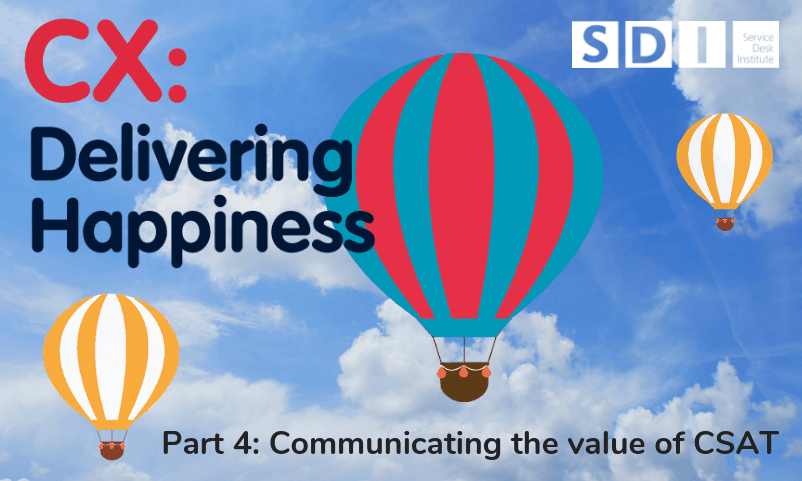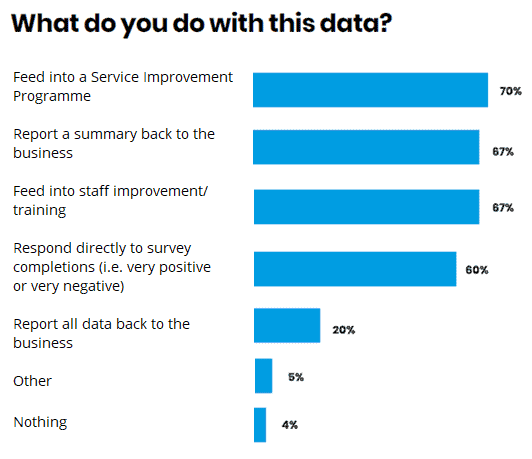
CX: Delivering Happiness
The ‘CX: Delivering Happiness’ Series is all about the shift in the ITSM industry which is beginning to steer the focus away from traditional metrics and towards recognising the significance of the customer experience. It will focus on everything from the ‘why’ and ‘how’ to measure CX, what affect it will have on service desks in the future, and even ways to take part in upcoming industry opportunities, ensuring you don’t get left behind. In part 4 we focus on creating and communicating value from your CSAT and CX data.
Part 4: Communicating the value of CSAT
In part 2 of the CX series, we explored methods of measuring CSAT and monitoring CX. We also pointed out that the frequency of which the service desk reviews and analyses data is crucial to gaining real value from customer feedback.
However, another key consideration in improving CX is what you do with CSAT data after reviewing and analysing it. According to the SDI Global Best Practice Service Desk Standard, when managing CSAT survey results, simply analysing the data is a reactive process, whereas as publishing and using data to make improvement decisions is seen as proactive.
There are several things that can be done using CSAT data as an input. In the Customer Experience report, we asked respondents what they do with this data to derive value:
 Feeding customer feedback into a service improvement programme is the most common thing to do with CSAT data. Utilising customer insight from the ‘other side’ i.e. the side of the service which support staff rarely see, the service desk is able to identify ways to improve provision, to enhance customers’ experience.
Feeding customer feedback into a service improvement programme is the most common thing to do with CSAT data. Utilising customer insight from the ‘other side’ i.e. the side of the service which support staff rarely see, the service desk is able to identify ways to improve provision, to enhance customers’ experience.
Another action you could take to gain more value from your CSAT data is to respond to specific survey completions, i.e. very positive or very negative. If handled well, an angered customer’s perception and experience of the service desk can be neutralised and in some cases reversed to form a positive view if managed in the right way. Communicating with them effectively, assuring them their experience is being looked into and acted upon and essentially letting them know they are being listened to is key.
Similarly to other performance metrics, it may be pertinent to provide a condensed or summarised report of CSAT data to relevant stakeholders; this can help demonstrate the value of the service desk as well as show how new or recent investments and implementations have affected performance and the current perception of the service.
Managing CX after change
Perhaps one of the most crucial times to manage customers’ experiences is during and after a large-scale release or the implementation of a new process or technology. Change of any kind can have an impact on the quality or speed of IT services, which can result in lower productivity, loss of revenue, and a larger volume of contacts to the service desk. Sometimes, this is unavoidable.
However, what can be avoided, or at least minimised, are negative customer experiences. By communicating effectively with customers and managing their expectations, customers are more likely to appreciate the service desk despite issues with IT services. Ensuring these customer experiences are well-managed will likely reflect the CSAT data collected, this can then be relayed to the business to demonstrate the value and appreciation of the service desk.
Communicating value
Often, the service desk is seen as a cost to the business, i.e. a part of the business that does not directly produce profit, but that costs money to operate. Therefore, service desks must often show ROI for a large-scale change or release, a tool or implementation, or indeed their service as a whole. While ROI can be calculated in monetary terms, it is important to note that CSAT measures can also be used to communicate the value of the service desk to the business. In fact, in some circumstances, CSAT data may provide a more balanced view as it may be representative of the intangible ROI of the service desk. This is because low costs and increased revenue for the business is not necessarily indicative of a valuable and efficient service for the customer.
Need to work on communicating the value of your service desk?
Take a look at SDI’s brand new CX WORKSHOP and discover how to:
* drive customer-centric service improvement
* define an end-to-end approach to managing your customers’ experiences
* feedback results to the business.


























